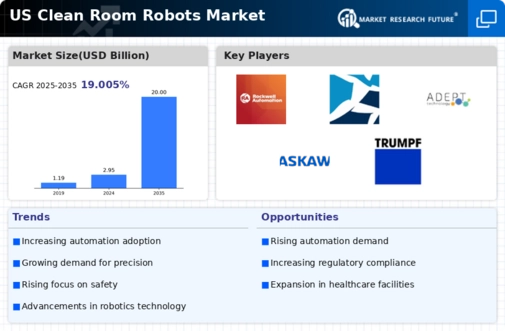The US Clean Room Robots Market has experienced a substantial transformation due to the increasing demand for automation and technological advancement across various industries, including pharmaceuticals, semiconductor manufacturing, and aerospace.A competitive landscape has emerged with key players leveraging innovations in robotics, artificial intelligence, and machine learning to enhance operational efficiency and precision within controlled environments.
The growing emphasis on maintaining stringent cleanliness standards in clean rooms further drives the adoption of robotic solutions, leading to an evolving market where companies strive to differentiate themselves by offering advanced features such as integrated sensors, real-time data analytics, and user-friendly interfaces.The competitive dynamics of this market are characterized by a focus on research and development, strategic collaborations, and a commitment to sustainability, enabling the participants to capitalize on opportunities arising from regulatory compliance and the need for improved productivity.
Rockwell Automation has positioned itself as a formidable entity in the US Clean Room Robots Market by emphasizing its expertise in industrial automation and control solutions. Its notable strengths lie in its comprehensive portfolio of automation products combined with robotics technology, tailored specifically for clean room environments.The company benefits from a strong brand reputation and a widespread distribution network that enhances its market presence. Moreover, Rockwell Automation continuously invests in technology advancements to provide customizable solutions that meet the exacting specifications of clean room applications.
The integration of IoT capabilities into its robotics products enhances operational efficiency and data analysis, allowing clients to achieve optimal performance in maintaining cleanliness standards. This strategic focus enables Rockwell Automation to remain competitive while catering to the evolving needs of industries requiring high levels of contamination control.iRobot, widely recognized for its innovative approach to robotics, has made significant strides within the US Clean Room Robots Market by offering a range of cleaning solutions designed for sterile environments. The company's strengths include its advanced automation technology and robust product portfolio that highlights versatility in applications suited for clean rooms.
iRobot leverages its longstanding experience in consumer robotics to bring intelligent cleaning solutions to industrial sectors, enhancing efficiency and effectiveness in maintaining cleanliness. The company's presence in the market is bolstered by continual efforts in research and development, including the introduction of smart robots equipped with sensors and sophisticated software capabilities.
Additionally, iRobot's proactive strategy includes strategic partnerships and collaborations aimed at enhancing its product offerings while exploring potential mergers and acquisitions to expand market reach and technological capabilities.This ongoing evolution positions iRobot as a competitive player focused on addressing the specific requirements and challenges faced in clean room environments in the US.















